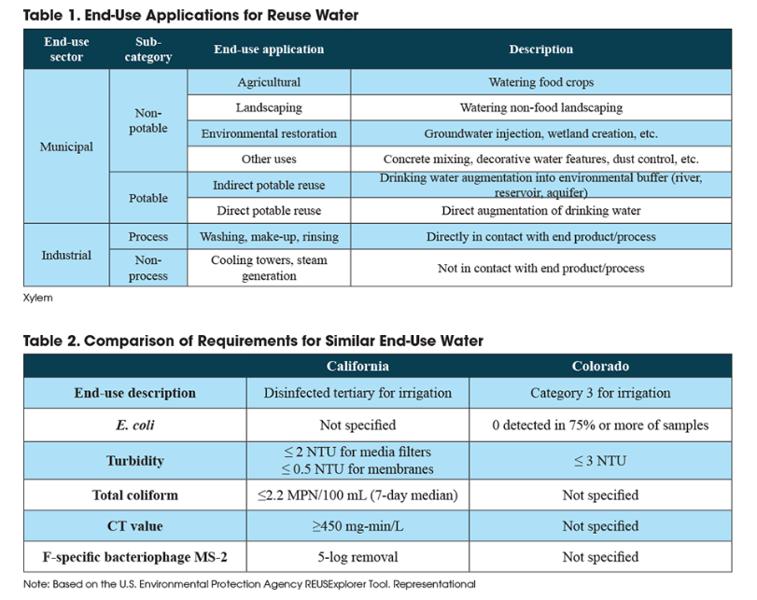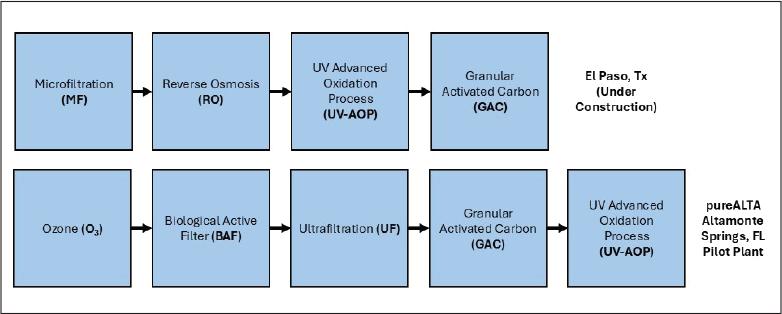Why fly without a pilot? How pilot projects and demonstration facilities smooth the water-reuse journey.
![]()
Increasing water stress in regions such as the U.S. Southwest and southern Europe is not the only reason why pursuing water reuse is gaining altitude in the water sector. Rising energy costs, expanding regulatory requirements, resilience challenges, and a renewed consideration of the total cost of water are among an array of other pressures driving utilities and industries to chart new courses toward secure, sustainable reuse for both potable and nonpotable end uses (see Table 1, below).
However, getting any water-reuse scheme off the runway is a complex undertaking without one-size-fits-all protocols. Depending on intended end use, water-reuse systems must meet widely varying effluent quality requirements that often differ not only across goals, but also jurisdictions and local regulatory requirements. Effluent requirements vary between California and Colorado with respect to irrigation water used for residential purposes (see Table 2, below). These differences could mean contrasting targets for factors such as turbidity, total coliform, log-reduction value, and more, all of which could necessitate entirely different treatment processes and technologies. For instance, two treatment trains — each designed for direct potable reuse — can take diverging paths to reach different regulatory destinations (see Figure 1, p. 38).
Beyond these considerations, factors such as budgetary constraints, site footprint, owner or engineering consultant preference, influent quality, minimal acceptable allowance for failure, and public perception also can influence equipment selection and treatment-train configuration.
With so many site- and circumstance-specific considerations to manage when plotting a path for a new water-reuse system, water professionals must ask themselves: Why fly without a pilot? While sometimes overlooked given the additional timeline and costs they can add to a project, pilot projects and demonstration facilities serve as vital test flights before a full-fledged reuse system earns its wings.
Preflight preparation pays off
While similar, pilot projects and demonstration facilities each are more appropriate for different scales and goals. Pilot projects typically are better suited for lower flows in the area of 150–400 L/min (40–110 gal/min) and aim mainly to optimize performance: testing unique conditions and using the gathered data to design the treatment train. Demonstration facilities normally are sized for higher flow rates up to approximately 3,785 L/min (1,000 gal/min) with the primary goal of showcasing consistent long-term performance. In some cases, a single facility can function as both a pilot and a demonstration if the design can represent full-scale operation but also is flexible enough to test important parameters and variants.


![]()
Equipment piloting and demonstration can offer significant benefits for reuse projects.
Site-specific performance testing
The critical nature of water reuse provides limited allowance for failure. Therefore, site-specific testing and subsequent performance validation of effluent quality mitigate risk of improper equipment design or selection. Successful site testing converts design conversations from "it should work" to "it will work" — a powerful distinction when interacting with key stakeholders such as facility owners or the community.
Improved design parameters
No two influent streams are the same, and without empirical data, equipment sizing defaults to "standard" design values. While likely reliable, standard design values will not allow a system to operate at full potential for its specific circumstance, which is especially critical with advanced water reuse. Onsite testing can empirically determine parameters such as ideal flux rate, backwash frequency, and other metrics. These design parameters then can form the basis for optimal, full-scale system design.
Variant testing
Pilot testing not only allows system managers to run equipment at a steady state, but also provides an opportunity to test variations of performance parameters. Chemical dosing rates, type of chemicals used, flow rates, pressures, etc., can be modified to understand the impact on the system under controlled conditions.
Reviewing various polymers and coagulant types is an example of variant testing. Different wastestreams will respond differently to an anionic or cationic polymer or to aluminum sulfate or ferric chloride. Alternatively, system managers can explore the performance differences of equipment arrangement and positioning. Learning the impact from different scenarios can improve performance at startup and provide valuable insight not as readily obtainable in full-scale operation.
Stakeholder confidence and public perception
The primary function of demonstration facilities is to provide confidence and build trust with key stakeholders such as end users, consumers, and the public. These facilities empower communities to see water reuse in action, often opening the doors for public tours and real-time water quality monitoring. These pilot projects turn technical discussions into tangible proof, helping to build trust and break down the perception barriers that can hinder reuse projects.
Several reuse-minded organizations have gone the extra mile by constructing permanent demonstration facilities and visitor centers that invite the public to view the technology. Pure Water San Diego, a reuse partnership that aims to provide nearly 50% of San Diego’s water supplies locally by the end of 2035, demonstrates the impact of having a demonstration facility. More than 20,500 people have toured the advanced reuse demonstration facility, with an additional virtual-tour video receiving more than 19,000 views so far.
Looking further, the HypoWave+ pilot project located in Wolfsburg-Hattorf, Germany, featured an onsite greenhouse containing crops grown with reuse water. During the piloting phase, interested individuals were able to visit the greenhouse and see the process and its benefits firsthand.
Operator familiarity
Through pilot testing, operators can get hands-on experience and exposure to equipment they may be required to operate at peak performance, as well as equipment with which they may not be familiar. Their early involvement, especially during periods of pilot optimization, can create a foundation of knowledge that will catalyze the success of the full-scale system. Furthermore, feedback from operators provides a unique perspective that can improve overall facility design, improving long-term resiliency and ease of operation.
Operating expense modeling and planning
The accuracy of financial analyses for reuse projects is critical. Operating costs of water-reuse treatment trains often represent a significant expense, and pilot testing can help provide more transparency in identifying these ongoing costs. While long-term labor costs for equipment maintenance remain difficult to estimate, pilot testing can determine costs associated with chemical consumption, energy use, oxygen consumption (with respect to ozone), and more.
Developing a sound flight plan
Despite its benefits, piloting may not be necessary for some projects. When reviewing the need, consider:
- the familiarity of stakeholders with reuse;
- the complexity or simplicity of the equipment scheme; and
- the consequences if the equipment underperforms.
For example, in Spain, where water reuse already is common, piloting for an irrigation application likely is unnecessary given the vast acceptance of the technology and the simplicity of equipment commonly used, such as tertiary filtration and ultraviolet disinfection.
Following the decision to pilot, it is critical to develop a thorough piloting plan. It would be exceptionally disappointing to complete a lengthy pilot program only to realize that the collected data do not provide useful insight or that no data were collected altogether. The following items are worth discussing during pilot-plan development.
Equipment and scale
What equipment is critical to test for this application? For potable reuse, one should test the entire treatment train. However, for nonpotable reuse applications, it may be suitable to test only a portion of the treatment train. Testing various treatment options or configurations also may be a consideration.
The project’s scale is an important consideration, too. For example, modern, full-scale ultraviolet reactors in the U.S. are validated according to U.S. Environmental Protection Agency guidance that allows operation at target log-removal value for specific contaminants. Testing with small, nonvalidated pilot reactors might not provide the information required to upscale the required ultraviolet doses.
Piloting team
Piloting should not occur in an echo chamber. All parties, from the consultant to the operator, should take part in the process. For most, there is no greater learning environment than hands-on, visual learning. Roles and responsibilities should be defined clearly amongst the various groups. Agreeing to ownership ensures installation, startup, and operation of pilot equipment occurs smoothly.
Testing parameters
Before any equipment ships to the site, spell out the various testing regimes to complete and the subsequent data desired. If looking at various ozone doses, what incrementable doses should be tested, for how long should each dose be run, and what tests should be taken? Building out well-organized data charts for each test case can allow for a universally understood plan.
Remember to build in flexibility as well as a buffer of additional time. Hiccups often occur during piloting that take time to resolve — expecting hold-ups and building a timeline accordingly can help promote success.
![]()
Logistics
Often overlooked but essential to any pilot project or demonstration facility, minor details can significantly impact performance. Be sure to review key items such as power connections, influent and effluent hookups, how influent and effluent are transferred (for example, via pump or gravity), scope of supply for installation, and available funding for testing.
Celebrating smooth landings
Around the U.S., communities are reaping the long-term rewards of thoughtfully designed pilot projects and demonstration facilities as their systems enter full-scale operation.
The pureALTA project in the City of Altamonte Springs, Florida, is a potable reuse demonstration/pilot facility that had a testing period of 12 months. While the produced water was recycled back to the water resource recovery facility, the testing provided significant benefits including obtaining future design data as well as validating a reverse-osmosis-free system for direct potable reuse.
As a forerunner of water reuse, the City of Colorado Springs, Colorado, executed the PureWater Colorado Mobile Demonstration project to explore the benefits of direct potable reuse in the state. Beyond open public tours, the purified water was made into consumable products by a variety of beverage producers, spanning from pale ales to soda.
As potable water supplies are strained by a growing population, Polk County, Florida, operates a direct potable reuse demonstration facility at its Cherry Hill Water Production Facility with a long-term goal of producing 5.7 ML/d (1.5 mgd) of reuse water. Data validating treatment quality were gathered over a period of 12 months, and the facility will remain open as an education center to showcase the potential and safety of direct potable reuse.
Water reuse, especially when supported by rigorous pilots or demonstration facilities, provides a sustainable, local solution to resilience challenges that is not dependent on rainfall or distant rivers. By investing in pilot projects today, municipalities and industrial users alike can ensure water security for the future, protect public health, and safeguard economic growth in a changing climate.
Matthew Roegner is a Global Product Manager, and Thomas Franz is a Global AOP and Reuse Manager at Xylem (Washington, D.C.).
